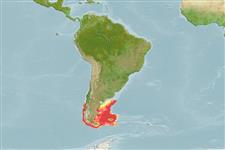Environment: milieu / climate zone / depth range / distribution range
Ökologie
seewasser demersal; ozeanodrom (Ref. 51243); tiefenbereich 30 - 1000 m. Subtropical; 40°S - 57°S, 76°W - 55°W (Ref. 1371)
Southeast Pacific and Southwest Atlantic: Patagonian region of Chile and Argentina, including the Falkland Islands and the Strait of Magellan.
Size / Gewicht / Alter
Maturity: Lm ? range ? - ? cm
Max length : 50.0 cm TL Männchen/unbestimmt; (Ref. 1371)
Rückenflossenstacheln (insgesamt): 0; Rückenflossenweichstrahlen (insgesamt): 59-70; Afterflossenstacheln 0; Afterflossenweichstrahlen: 54 - 63; Wirbelzahl: 52 - 54. A small variably shaped patch of teeth on head of vomer. Pectoral fin extending beyond anal fin origin. Ventral light organ present. Color uniformly brown; fins dark-edged (Ref. 1371). Caudal fin rounded (Ref. 27363).
Highest catches at 235 m. Females attain larger sizes than males. Larger individuals of both sexes move into deeper water. Utilized mainly for fishmeal; can be fried, microwaved and baked (Ref. 9988).
Life cycle and mating behavior
Geschlechtsreife | Fortpflanzung | Ablaichen | Eier | Fecundity | Larven
Cohen, D.M., T. Inada, T. Iwamoto and N. Scialabba, 1990. FAO species catalogue. Vol. 10. Gadiform fishes of the world (Order Gadiformes). An annotated and illustrated catalogue of cods, hakes, grenadiers and other gadiform fishes known to date. FAO Fish. Synop. 125(10). Rome: FAO. 442 p. (Ref. 1371)
IUCN Rote Liste Status (Ref. 130435)
Bedrohung für Menschen
Harmless
Nutzung durch Menschen
Fischereien: weniger kommerziell
Mehr Information
NamenSynonymeMetabolismusRäuberÖkotoxikologieFortpflanzungGeschlechtsreifeAblaichenSpawning aggregationFecundityEierEientwicklung
Tools
Zusatzinformationen
Download XML
Internet Quellen
Estimates based on models
Preferred temperature (Ref.
123201): 3.3 - 7.7, mean 5.7 °C (based on 115 cells).
Phylogenetic diversity index (Ref.
82804): PD
50 = 1.0000 [Uniqueness, from 0.5 = low to 2.0 = high].
Bayesian length-weight: a=0.00468 (0.00277 - 0.00790), b=3.11 (2.96 - 3.26), in cm total length, based on LWR estimates for this species & (Sub)family-body (Ref.
93245).
Trophic level (Ref.
69278): 4.4 ±0.3 se; based on diet studies.
Widerstandsfähigkeit (Ref.
120179): mittel, Verdopplung der Population dauert 1,4 - 4,4 Jahre. (Assuming tm=2-3).
Prior r = 0.57, 95% CL = 0.37 - 0.85, Based on 1 stock assessment.
Fishing Vulnerability (Ref.
59153): Moderate vulnerability (40 of 100).
Climate Vulnerability (Ref.
125649): Moderate to high vulnerability (54 of 100).
Nutrients (Ref.
124155): Calcium = 58 [29, 126] mg/100g; Iron = 0.945 [0.508, 1.791] mg/100g; Protein = 17.6 [15.2, 19.6] %; Omega3 = 0.26 [0.13, 0.50] g/100g; Selenium = 44.8 [20.4, 95.5] μg/100g; VitaminA = 23.2 [6.5, 84.7] μg/100g; Zinc = 0.592 [0.395, 0.902] mg/100g (wet weight); based on
nutrient studies.
